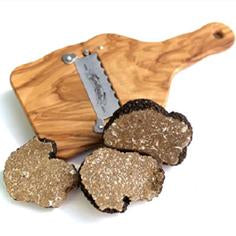
The summer truffle
Are you aware that there are many Black Truffle varieties in the world?
But only a few are considerably valuable Black Truffle botanical species by the gastronomical point of view.
The most common of Black Truffle species is the Tuber Aestivum Vitt., commonly called “Summer Truffle”.
Summer Truffle is a variety vastly present in Europe, especially in the South (Italy, France and Spain) and in Eastern Europe (Romania, Bulgaria) as well as in the Balkan Regions (Croatia and Slovenia).
Summer Truffle is bluish-black in color and has a very crumpled and thick peel, created of countless small pyramidal warts. In its inner part, Summer Truffle is brown in color (from light brown to a hazelnut color, depending on the plant and the land of origin) and it is crossed by distinctive light veins. It is a truffle with a hard consistency to the touch, less delicate to handle than the other truffle varieties, with a longer shelf life than White Truffle (fresh Summer Truffles can last up to 15 days after harvest).
In Piedmont, the most prized Summer Truffle is found in hazelnut groves and has a characteristic dark brown color. This variety of truffle has a very long season: it is harvested between the months of May and October. Although it is not a particularly fragrant variety when it is compared to the Fall varieties, we at Tartuflanghe like it for its predominantly discernable taste, with hints that recall mushrooms, the undergrowth and hazelnuts. We especially like it served on hot dishes, because the heat and steam give off all of its fragrance.
Have you ever tried our Summer Truffle slices in olive oil ? The tasty slices of Summer Truffle preserved in olive oil are very convenient, ready to be used and be paired in any of your dishes: in addition to any type of pasta, have you ever tried it on a meat fillet? Or on fish? Or on pizza? Or on eggs? Or even on a slice of your favorite cheese? Also, the leftover preserving oil is a delicious seasoning that can be added to any of your recipes.

Leave a comment